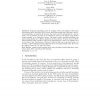Free Online Productivity Tools
i2Speak
i2Symbol
i2OCR
iTex2Img
iWeb2Print
iWeb2Shot
i2Type
iPdf2Split
iPdf2Merge
i2Bopomofo
i2Arabic
i2Style
i2Image
i2PDF
iLatex2Rtf
Sci2ools
COLT
1994
Springer
1994
Springer
An Optimal Parallel Algorithm for Learning DFA
: Sequential algorithms given by Angluin 1987 and Schapire 1992 learn deterministic nite automata DFA exactly from Membership and Equivalence queries. These algorithms are feasible, in the sense that they take time polynomial in n and m, where n is the number of states of the automaton and m is the length of the longest counterexample to an Equivalence query. This paper studies whether parallelism can lead to substantially more e cient algorithms for the problem. We show that no CRCW PRAM machine using a number of processors polynomial in n and m can identify DFA in on=logn time. Furthermore, this lower bound is tight up to constant factors: we develop a CRCW PRAM learning algorithm that uses polynomially many processors and exactly learns DFA in time On=log n. Key Words: computational learning theory, query learning, membership query, equivalence query, DFA, optimal parallel learning
Related Content
| Added | 09 Aug 2010 |
| Updated | 09 Aug 2010 |
| Type | Conference |
| Year | 1994 |
| Where | COLT |
| Authors | José L. Balcázar, Josep Díaz, Ricard Gavaldà, Osamu Watanabe |
Comments (0)

